I went to Alchi Monastery looking for the ancient paintings of a distinct style that sets it apart from other religious centers in Ladakh. Trees laden with apricots and the swift flowing Indus River were an added bonus.
My bus passed through lush green oasis of saspol village on its way to Alchi. After two hours on the road west of Leh along the Indus River, the bare mountainscape temporarily made way for a relatively flat terrain teeming with apricots and apples amidst barley fields. The apricots trees with numerous fruits looked more yellow than green. Apple trees were irresistibly red.
Just across the river, Alchi Village has one of the oldest standing structures anywhere in Ladakh. The Alchi choskor or the ‘religious enclave’ is dated approximately to eleventh century and has an architecture very unlike other monasteries in the region. It was abandoned as a place of worship and remained unknown to rest of the world, till historians unearthed the treasured paintings in the choskor only a few decades ago. On hindsight, its desertion seems to have worked well in its preservation. The monastery escaped destruction from Kashmiri invaders four centuries years ago as much as it escaped renovation and restoration from the Ladakhi monks.
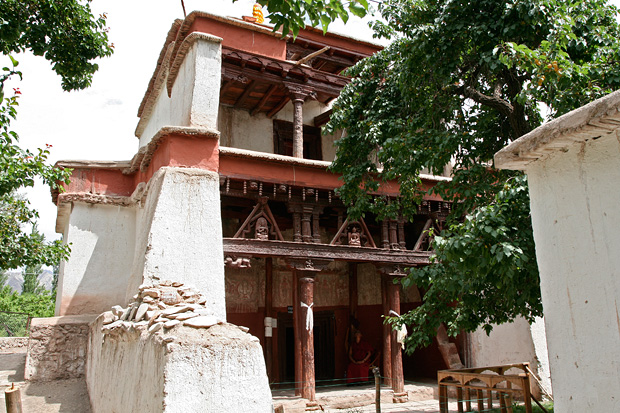
Sum Tsek at Alchi Monastery
Walking past the small village and along a narrow path on the banks of Indus, I entered the monastery that wore a deserted look. It did not have the usual buzz of playful kid-monks running along the corridor chasing each other or the smiling elderly lamas in ochre robes walking slowly as they chanted some mantra. Also missing were the randomly built living quarters that usually spread around the prayer hall, the quadrangle where the festivals are held and the colourful paintings on the front walls. The choskor looked more like a bunch of randomly built houses with a few apricot trees surrounding them.
The drab exteriors though, are a contrast to the colourful inner walls. Once inside, I see every inch of the wall covered with small paintings. The sum-tsek—the main temple in Alchi—is a three story building with colourful paintings in its inner walls. It takes some time to get used to the interiors kept dark to preserve the paintings. The colours start coming alive as the eyes slowly get accustomed to the darkness. The walls are covered from end to end with thousands of small colourful images of Buddha. At the center of three inner walls are three-story high statues of incarnations of Buddha—Avalokiteshwara, Maitreya and Manjushree. The upper half of the Buddha statues are not visible from below, as they stand above the first floor where the weakening structure doesn’t permit access.
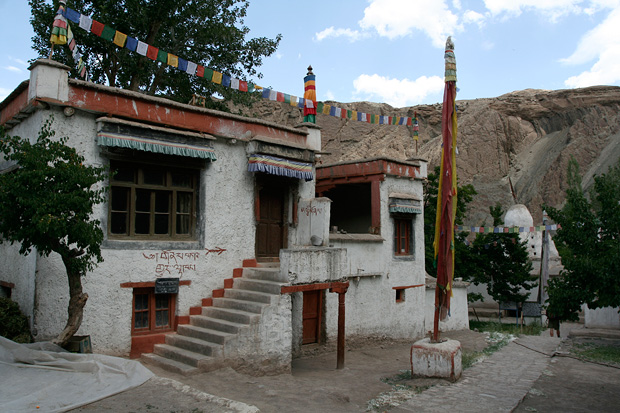
A section of the monastery
At the neighbouring prayer hall are equally colourful but a diverse variety of paintings that include a sailing ship, people wearing clothes that look Central Asian and other secular images that are evidently not Ladakhi. The paintings in Alchi vary considerably from other monasteries influenced by Tibetan culture and its animist origins. It doesn’t carry the extraordinary characters and stylization with demonic and unearthly features commonly seen on the walls of most other monasteries. On the contrary, they are said to bear resemblance to Buddhist paintings from the Indian plains, indicating that Alchi was perhaps built in a time when a wave of Buddhist preachings spread into Ladakh from Kashmir and North India. Historians often refer to this as ‘second spreading of Buddhism’ against the first arrival of the religion in Ladakh from Tibet. Among the Himalayan Buddhist centers, only other surviving monastery with paintings similar to Alchi are found in Tabo Village in Lahaul and Spiti. Both monasteries are now in the tentative list of UNESCO World Heritage sites.
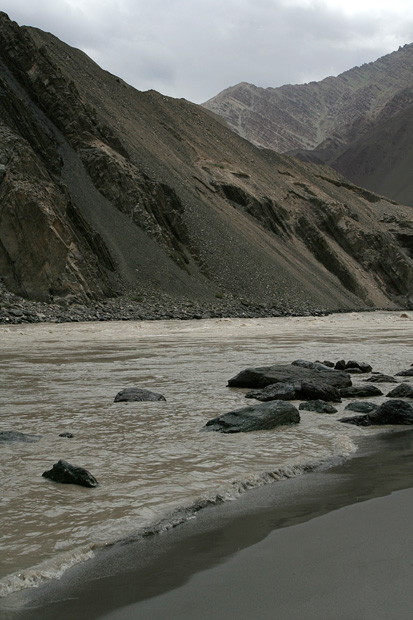
Just outside the monastery, Indus River flows swiftly in a depression carved by its currents. I walked down to the river bank and spent some time watching its fast flowing muddy current before making my way back to Leh in the evening.
Information
The Alchi choskor complex has five buildings. The sum-stek or the three story temple has three-story high statues of Avalokiteshwara, Maitreya and Manjushree, with its walls painted with thousands of small Buddhas. The dukhang or the main prayer hall is larger with two sections and has many secular and religious paintings. The Manjushri Lhakhang, Lotsawa Lhakhang and Lhakhang Soma are the smaller temples.
Alchi Monastery is known for the historical value and uniqueness of the paintings. It is no longer in use as a religious place, though it is maintained and managed by the monks of nearby Likir Monastery.
How to reach. Alchi is 65km from Leh downstream Indus. Most tourists hire a cab to get there, though Alchi is well connected by public transport from Leh (about 3 hours). If you are taking a bus from Leh, it is better to be informed about the timings beforehand. Ask your hosts in Leh or check at the bus-stand a day before.
Food and Accommodation. If you are on a day-trip from Leh, Alchi Village has a few restaurants just outside the monastery. In front of the the choskor is a place run by Likir Monastery, where food and accommodation is available. There are a few more guesthouses and hotels available in Alchi for those who would like to stay at the village.
Map and driving directions.
View Leh to Alchi in a larger map
See glossary for meaning of terms marked in bold below.
How can a photographer assume rights to treat a human being like an inanimate exhibit? It is hard for me to conceive stepping right into someone’s personal space with a big mean digital SLR and shoot a few hundred images using a long lens poking up to the nose of the person being photographed. As if that is not bad enough, the photographer never spoke a word. No smile, not even a hello. Instead, he went on clicking as though he was shooting a sheep, or even worse, a museum piece. He took his time to take pictures from various angles and went satisfied only after every inch of his subject was photographed.
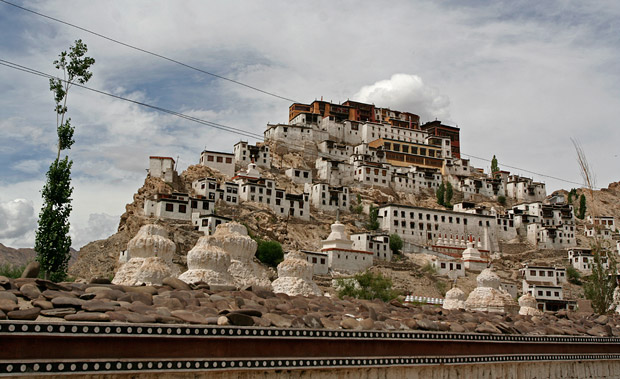
Yet, lama Sherap did not seem annoyed. He did not even blink at the photographer or showed the slightest discomfort. He simply continued at his work and once in a while looked up and smiled. He wasn’t perturbed even when the smile did not result in a reciprocation. After the mean photographer left without saying a ‘thank you,’ he looked at me and smiled as if telling me not to bother. I was sitting there talking with lama Sherap for a while and was very annoyed by the photographer’s behaviour. But the lama himself seemed to live up to what they learn – he was perfectly composed and simply resumed his work as though nothing happened.
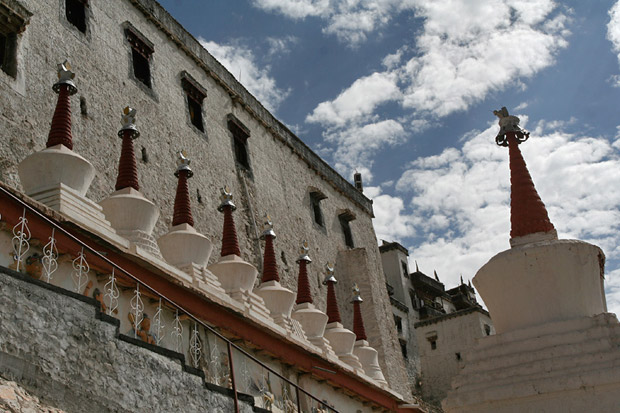
Lama Sherap was taking care of the du-khang that day. He was alone in the prayer hall as his companions had gone to the village to perform some rituals. He was friendly, approachable and smiled gently every time he spoke. Sitting on the floor close to the entrance of the hall, he busied himself kneading chunks of tsampa (barley flour) and preparing torma. He explained me what torma is and helpfully added that it is for some special prayers being performed tomorrow.
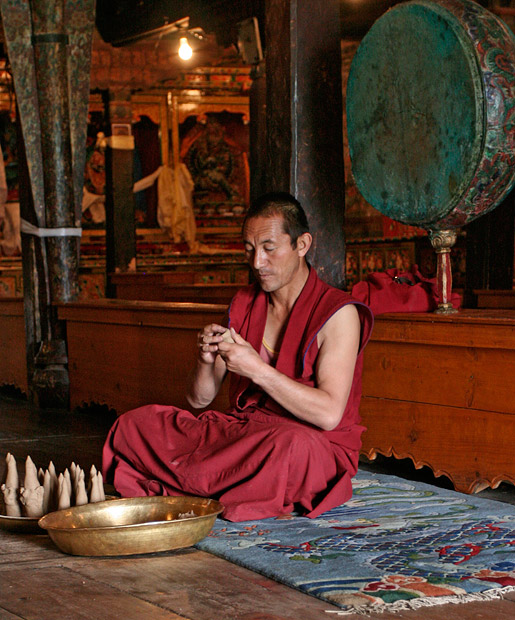
As I sat and talked to with him, a Ladakhi woman walked in, greeted the lama with a smile and a ‘julley’, prostrated repeatedly towards the altar and and left as quickly as she came. Tourists kept coming in packs, took pictures and left within minutes, having ticked Thiksey off their list. After the nosy photographer completed his work, lama Sherap asked me how a digital camera works.
‘Today’s cameras don’t have film rolls and you can see the pictures at the back of them,’ he said, ‘where do the photos get recorded?’ I took out the CF card from my camera and showed him in answer. His next questions came immediately.
“How may photos get stored on them? They could get 36 in a roll of film. In which country do they make these things?”
After satisfying his curiosity, it was my turn to ask questions. Lama Sherap showed me a statue of Tson-ka-pa, helpfully identified it for me and explained that the monastery belongs to Gelugpa order. ‘There are about a hundred lamas,’ he said, ‘some are young lads and some are more than forty years old.’
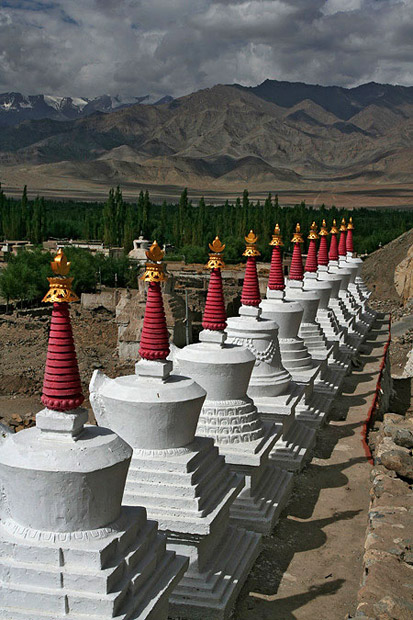
As long as I was with him, he never saw his smile go away. When tourists misbehaved, sitting on the carpets that were meant only for lamas, he would wait to see if they would rise soon and then offer them another seat. There was not the slightest hint of irritation or anger despite repeated violation of regulations by visitors. Later at chon-kor, the room with a large idol of Buddha Maitreya, I saw a visitor stumble and drop a lamp on the floor and guiltily look at the monk taking care of the room, only to see him smiling. What could be an embarrassing moment was instantly dissolved in those smiles.
The chon-kor has an impressive 2-storey high statue of Buddha Maitreya. The tall Maitreya sits in padamasana (lotus position) and has a calm unblemished face. His lotus-like crown is embellished with images of reincarnations of Buddha. His large ornate ear rings complement the crown and stand out against the turquoise outfit.
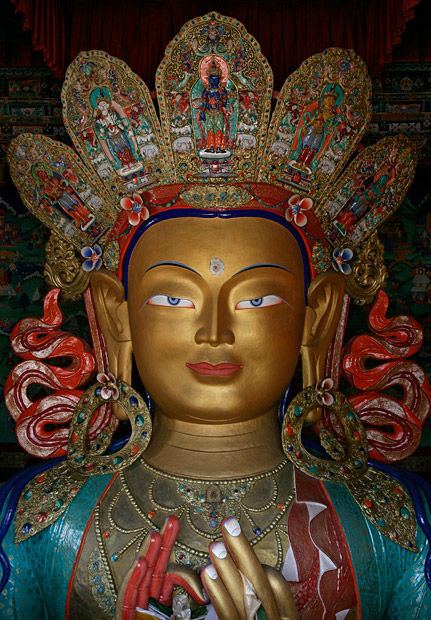
The Maitreya statue is relatively new, inaugurated in 1980 by Dalai Lama. The monastery itself was founded in early 15th century. Walking up the crag where a group of haphazardly built buildings of the monastery are located, it is evident that the institution has grown and expanded over the years. I climb up the steps leading to the monastery past a latest addition – a newly built row of chortens.
Inside, the du-khang seems to be old enough to be one of the first buildings built. To each side of its entrance are the colourful murals of the deities of the four directions, while inside walls are painted with various forms of Buddha and Yab Yum. At the rear side of du-khang is a small chapel with metallic statues of Tson-ka-pa and Manjushri.
The paintings on the outer walls have a curious diversion from tradition. The samsara-chakra has figures wielding guns and wearing clothes more suited for British and Indian men of the plains a few hundred years ago.
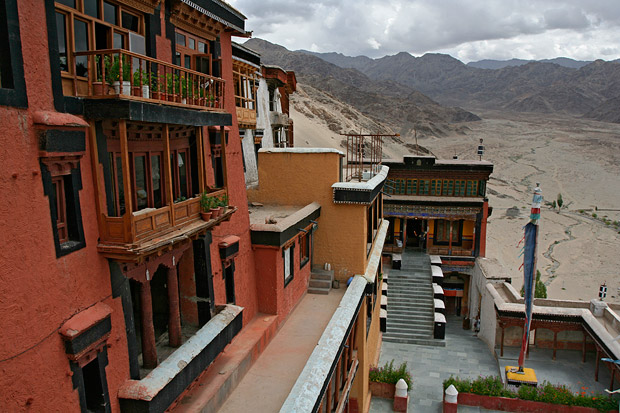
The stairs next to the du-khang lead to the terrace from where I can see the barley fields spread along the valley, the river coiling through the fields and the mountains beyond. In the corner of the terrace is a small room – a library filled with ancient Tibetan scriptures. As I descend from the stairs and head out to the valley, it is the smiles of Lama Sherap and the calm face of Maitreya that stay in my memory, etched stronger than the photographs I clicked in the monastery.
I went to Thiksey Village to see the monastery, but was charmed by the barley fields around the village more than the monastery itself.
See glossary for meaning of terms marked in bold below.
On my way to Ladakh from Manali, I had presumed entire Ladakh as a calm and pleasant region with a soothing feel and a mystic charm. But the urban growth and its ugly suburbs had baffled me, making me wish to move away from the town. Thiksey provided the necessary escape.
After having gone through the barren landscapes along the Manali-Leh road and spending days in Leh looking up at arid mountains all around the town, the greenery along the Indus Valley gave a welcome break. The river basin is at its widest in Thiksey, mostly filled with barley fields, poplar groves and a few houses dotting the verdant landscape.
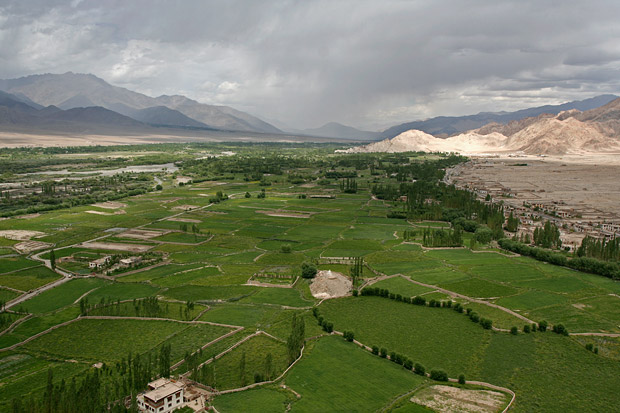
I walked through the fields listening to the cawing of bactrian magpies and watching a hoopoe lodge on the ground near me, spreading its crest like a fan and proudly demonstrating its beauty. Sparrows hopped around the fields in search of grain, chirping and flying away on my approach. The fields were crisscrossed by a complex array of canals with cold, crystal clear water coming down from the mountain peaks. A long Mani wall bordered the fields. Thin poplar trees grew tall and parallel to each other, forming boundaries between two patches of land. As the sun edged towards the mountain peaks in the west, the sky was painted in orange and shafts of light emerged from the gap in the clouds. Sunlight made way through the poplar trees, creating strips of light and shade on the ground.
A few women worked in the fields. Children gallivanted on the road, going back and forth without purpose.
Thiksey monastery was visible at a distance, perched high on a hill to the north, overlooking and guarding the village. Indus flowed somewhere below in the wide valley. Far away to the other side were the mountains of Zanskar, with their brown slopes and icy peaks. It was a beautiful world!
But there are some signs of Thiksey’s traditional barley fields giving way to development. Some fields were dug up for brick making, probably to satisfy the demand from Leh and to build accommodation for the summer rush of tourists. Poplar trees – another material used for construction – usually grown at the edge of the fields now completely occupied some areas.
As the sun went down the horizon and we headed back to our hotel, we met two soldiers from the nearby battalion. They were friendly and happy to talk, like most army men here were. Suman and Rishi have seen a winter here and can’t forget the harsh weather and sub-zero temperatures from those days.
‘It gets bitterly cold,’ they say, ‘-45C in winter. All the greenery that you are seeing today will be gone. There won’t be a shrub to see. The trees shed their leaves and look like skeletons. Nothing grows on earth. Vegetables cost ten times the summer prizes. The approach roads to Ladakh will be closed and there will be snow all over.’
Having seen a harsh winter, Suman preferred warmer climes. ‘You should go to Andamans,’ he told me, ‘see the sea there, go to Port Blair and visit the cellular jail.’ Without knowing, he was kicking up a wish I have had for a long time.
We parted ways and returned to the hotel, a place managed by the monastery administration. We intended to visit the monastery for the next morning prayers, but luck would go against us. Someone had died at the village yesterday and the monks were to go there to perform final rites. There would be no morning prayers in the monastery next morning.
To be continued..









